We Drive the Busted-Out BMW M3 Lightweight That Helped Develop Michelin Performance Tires
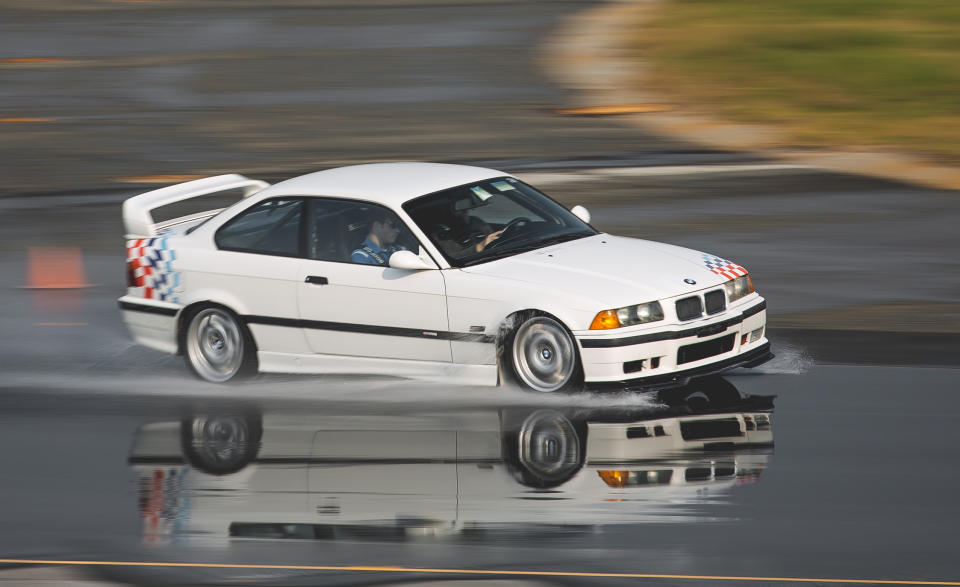
Tires have benefited from the digital age as much as Twitter has expanded the social game of POTUS, for better or worse. In the last decade, the spiciest street-legal tires have nearly surpassed the performance of a decade-old racing tire, and computer modeling is a big part of the reason. But as good as computers are at calculations, they can’t replicate human feel—yet. So prototype tires are still fitted to cars and run around tracks and handling roads by human drivers to fine-tune the product for human sensations. Probably much like you, we’d never thought too much about what cars were used as testing mules.
Which brings us to this particular car. During this author’s first trip to Michelin’s Laurens, South Carolina, proving ground nearly 10 years ago, I spotted a personal automotive hero: the 1995 BMW M3 Lightweight. For me, that car was the most special among the exceptional. As an avid car-magazine reader in my youth, the E36-generation M3 occupied a place in my automotive heart from which it would not be displaced. It was the first car I remember driving while thinking, “Ohhhh, this is what Car and Driver is talking about.” The car spoke to me, and the memory of it will always be magic. It was never the fastest thing on the road, and, yes, we got a neutered version in the United States, with a less powerful and technically inferior inline-six—European models got six throttle bodies and variable valve timing—and a slightly softer suspension than was used in Europe.
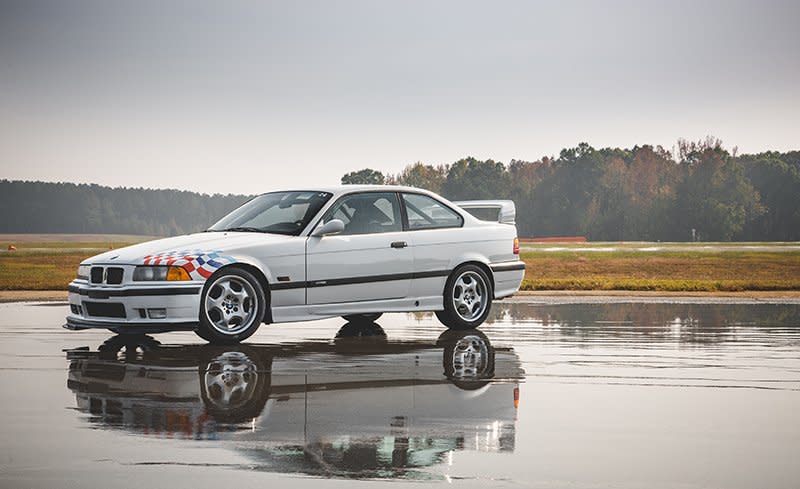
The 1995 Lightweight was as special then as would be the E92 M3 GTS in 2010 or even the F82 M4 GTS today. Just 11 preproduction and 115 production Lightweights ever existed. Surely many fewer survive today. For years, I thought that unicorn sighting in a Laurens parking lot was just a cool car owned by an engineer who happened to stretch its legs on the day I had passed through. I could not have been more wrong. The car is owned by Michelin. And it served as a precision tool for testing new tire designs. It lived, and occasionally died, on racetracks.
Why This Car?
Back in 1995, the E36 M3 was new to the U.S. and the Lightweight attempted to correct the neutering, albeit for an extremely limited number of owners. The CSL, as it is sometimes called, got the stiffer European suspension, a shorter 3:23:1 final drive, forged wheels, and hand-picked S50B30 engines good for a claimed 240 horsepower. In reality, the engines were probably a little more powerful. On the outside, all Lightweights were painted Alpine White with a tricolor checker M motif on the left-front and right-rear corners, used the adjustable front splitter borrowed from the Europe-only M3 GT, and had aluminum door skins. Buyers of Lightweights did without a radio or air conditioning in their cloth and carbon-fiber-trimmed interiors. Superfluous sound-damping material was jettisoned, too.
Lightweights also came with a plethora of parts in the trunk, including additional underbody bracing, a strut-tower brace, a larger oil pan with dual pickups to avoid starvation in high-g driving, and a park-bench-sized wing. Not every dealer installed all the parts, and cars often trade to this day with the extras still packed in their original plastic.
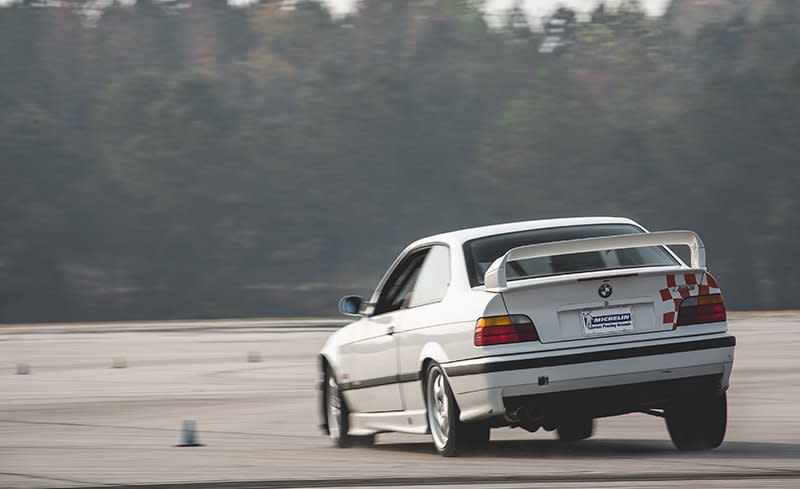
We tested one in August 1995. The short-legged differential, while great on paper, added shifts to the 60-mph dash, so it was actually slower in that metric than a particularly quick M3 we had in a ’94 comparison test, despite weighing 282 pounds less. That test car also had but 700 miles on the odometer; back then, BMW engines needed a thorough break-in to unlock maximum performance. We said “the Lightweight car is M3 espresso, pure and concentrated.”
Michelin purchased its Lightweight in March of 2000 with just over 10,000 miles on its odometer. It came with a roll cage installed by its previous owner, and it still wears a sticker on the window touting that owner’s flying club. To get it up to testing spec, Michelin installed a pair of racing seats (the originals are stored “somewhere,” according to Michelin’s mechanic) and five-point harnesses.
If you are anything like me, you’re thinking to yourself, “But why did Michelin need a Lightweight?” While it seems excessive for something so rare to be saddled with constant track duty, remember that Lightweights were not the six-figure investment in 2000 that they are today. First, it already had a cage in it. Second, Michelin starts all tire development with a square setup, meaning the same size tires front and rear. The Lightweight’s stock 235/40R-17 tires, all around, were right in the wheelhouse for performance tires at that time. Third, the car, at 2950 pounds, is fairly light and isn’t too hard on brakes, but it isn’t so light—as would be, say, a Mazda Miata—that the tires aren’t worked hard enough on a racetrack. Finally, and most important (as it is to us), was the naturally aspirated engine. A turbocharged engine would surely make the car quicker, but they are generally less sensitive to minute throttle changes, and crystal-clear communication is more important to any tester than is a lap time.

Almost immediately after Michelin bought it, the M3 Lightweight went to work as a test rig. The car has since contributed to the certification and development of many Michelin and BFGoodrich tires we’ve loved over the years, including the BFG g-Force R1, g-Force Rival, and g-Force Rival S and the Michelin Pilot Super Sport, Pilot Sport Cup 2, and new Pilot Sport 4S. If you are driving on a set of Michelin or BFG summer performance tires, they owe tribute to this M3.
Analog Subjectivity
Today, Michelin’s white knight is flirting with 50,000 miles of very hard duty. For 17 years, this E36 hasn’t (legally) seen a public road. Nearly every mile accumulated has been at the hands of a development engineer on a track; the most dialed-in of those guys and gals are the subjective evaluators. They would spend a whole day tracking upward of 12 sets of ever-so-slightly-different tires to fine-tune the feel. One of those former rubber jocks, Brandon Sturgis—who has since moved to a marketing role in the company—tipped me off that the E36 Lightweight was an engineering car.
Michelin agreed to let us take a closer look at the old E36 and even let us drive it a bit. The Lightweight still carries its own, er, weight, but the miles show. You can’t put your hand between the roll cage and the body when it is getting lifted in the air—which happens multiple times a day when testing tires—or the body flex will pin your fingers in place. That front splitter has been torn off countless times. The quarter-panels are peppered with stone chips like a period-correct vintage race car. And the tricolor décor, which was red, navy, and light blue when new, has faded like a war-torn flag. One of its coolest battle scars is dimpling on the hood from high-g loading. This BMW is far from perfect, and that makes it perfectly beautiful.
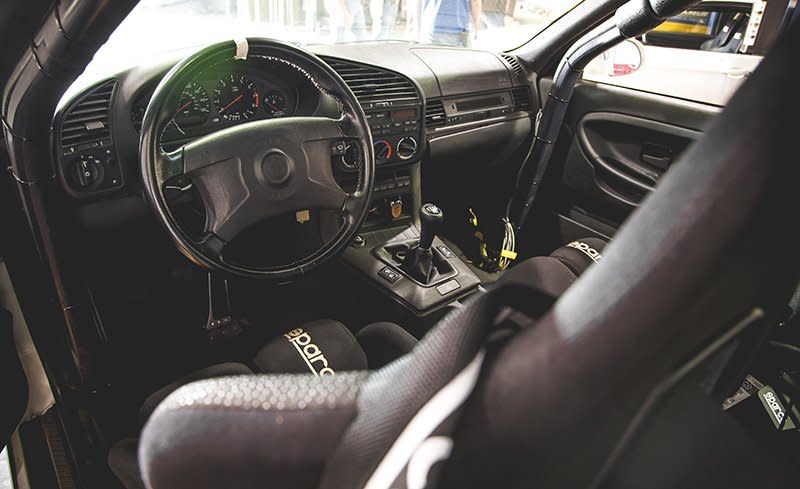
From behind the wheel, it is clear why Michelin selected this M3 as its benchmark. This car, even as ragged as it has become, continues to broadcast the status of a tire’s contact patch with crystal-clear five-by-five signal quality. Compared with a modern car, the big steering wheel feels slow in hand, but for every inch the wheels turn, they return yards of feedback. The Michelin-installed brake ducting occasionally falls off, and its engine has been spun past its operating range a few times, resulting in the replacement of the entire engine once and all 24 valves another time.
On Michelin’s wet Track 3, the E36’s long-travel throttle is an analog rheostat, smooth yet with immediate response. Even today’s computer-controlled and direct-injected supercar engines feel laggy by comparison. If going quickly in the wet is any indication of how good a car is, know that this 22-year-old BMW still holds the Track 3 record. But, as Sturgis remembers, running the CSL on T3 was torture because it doesn’t have air conditioning and the old sprinklers—which the Laurens Proving Ground has since replaced with a more controlled flooding system—meant the testers had to drive in 90-degree-plus South Carolina humidity with the windows up, while wearing a fire suit and a helmet. Maybe that particular set of conditions simply inspired the driver on that day to go just a bit quicker to shorten the endurance contest.
Out to Pasture
Use any good tool too much, and it will wear out, but the Lightweight’s capability or performance isn’t what ultimately led to its retirement. It’s that the car’s fenders won’t accept modern-size rubber. Also, in 1995 there weren’t multiple CAN busses in cars—a ’95 M3 has OBD I diagnostics. Subjective drivers rely on feel and view objective data with suspicion unless it backs up what they are saying, but modern cars spit out a metric ton of information just by connecting two wires. And that information can’t be ignored. So, basically, this test bench has finally become just too old.
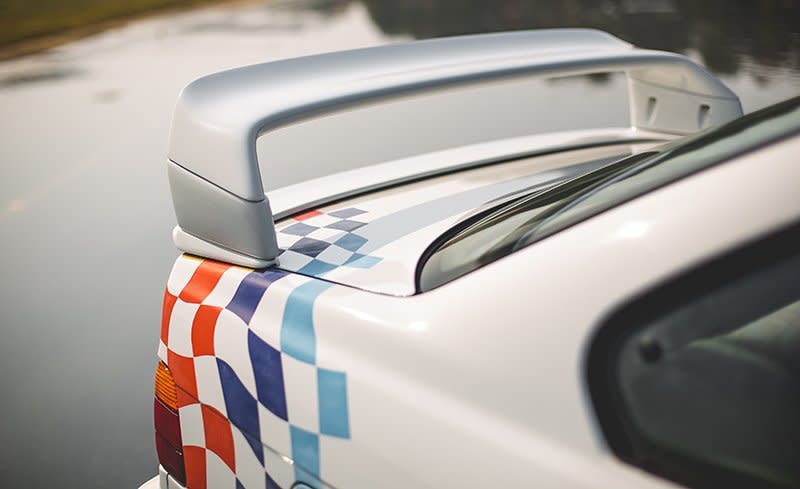
Michelin has replaced the Lightweight with a highly modified E92 328i. While the E36’s modifications were limited to race seats and a brake-pad and rotor combination (StopTech slotted rotors and Porterfield R4 pads, for those still tracking E36s) that maximized the service interval, the new-to-Laurens E92 coupe needed more. Michelin has installed M3 suspension components with stiffer bushings, a full roll cage, a race seat and belts, and cabin fire suppression. Why not just start with an E92 M3, or an F30 3-series, you ask? The E92 328i is naturally aspirated and its inline-six is far less costly to maintain than the E92 M3’s V-8.
Sarah Robinson, another former tire tester still working for Michelin, remembers the E36 fondly. She liked the Lightweight so much she claims to have “dibs” on it, if Michelin were to sell it, but the company isn’t sure what it will do with the old rig. We hope it remains in the family or becomes a museum piece—if there were a tire-test-car hall of fame, this M3 would belong there. Even if there’s another single car that is connected to as many kick-ass tires as this old mule, it wouldn’t be as rare. No one tests tires with a Bugatti EB110, but if they did, those are still more common than a 1995 BMW M3 Lightweight.
Specifications >
VEHICLE TYPE: front-engine, rear-wheel-drive, 5-passenger, 2-door coupe
PRICE AS TESTED: $48,470 (base price: $48,470)
ENGINE TYPE: DOHC 24-valve inline-6, iron block and aluminum head, port fuel injection
Displacement: 182 cu in, 2990 cc
Power: 240 hp @ 6000 rpm
Torque: 225 lb-ft @ 4250 rpm
TRANSMISSION: 5-speed manual
DIMENSIONS:
Wheelbase: 106.3 in
Length: 174.9 in
Width: 67.3 in Height: 52.6 in
Passenger volume: 84 cu ft
Trunk volume: 9 cu ft
Curb weight: 2950 lb
C/D TEST RESULTS*:
Zero to 60 mph: 5.7 sec
Zero to 100 mph: 14.5 sec
Zero to 130 mph: 30.2 sec
Zero to 140 mph: 42.1 sec
Rolling start, 5–60 mph: 6.3 sec
Top gear, 30–50 mph: 6.9 sec
Top gear, 50–70 mph: 7.1 sec
Standing ¼-mile: 14.2 sec @ 99 mph
Top speed (governor limited): 147 mph
Braking, 70–0 mph: 157 ft
Roadholding, 300-ft-dia skidpad: 0.88 g
C/D FUEL ECONOMY*:
Observed: 21 mpg
EPA FUEL ECONOMY:
City/highway: 19/27 mpg
*Test results from C/D, August 1995

 Yahoo Autos
Yahoo Autos 